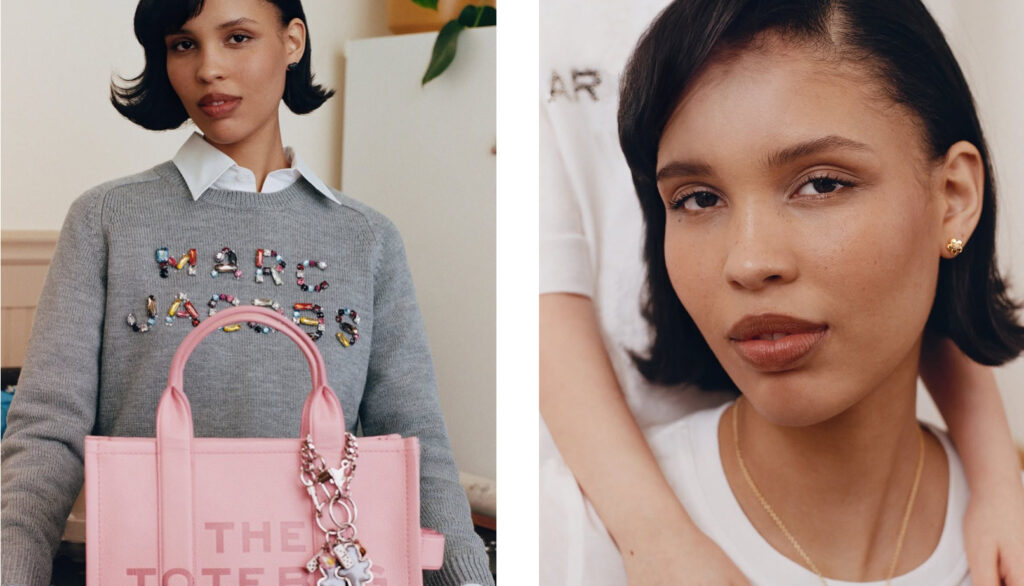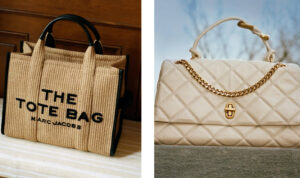A Modern Motherhood Narrative
In a world of fast fashion campaigns and fleeting messages, Marc Jacobs is taking a different route this Mother’s Day—one that’s tender, bold, and unapologetically real. The American fashion house has tapped Nara Smith, model, creative, and mother-of-three, to front its latest campaign. The result? A deeply personal, emotionally intelligent portrait of what motherhood looks like today: layered, powerful, and unmistakably chic.
Unveiled this week, the campaign is a visual ode to mothers not just as caretakers, but as creators, icons, and individuals in their own right. Shot in soft lighting, with nostalgic tones and modern silhouettes, the images are less about a product push and more about presence—a rare moment in fashion where the subject takes center stage, not just the clothes.
Why Nara Smith?
Marc Jacobs is no stranger to choosing unconventional muses. From Winona Ryder to Kim Gordon to the internet’s favorite alt-girl Devon Lee Carlson, the brand’s DNA has always leaned toward the culturally fluent and emotionally resonant. But Nara Smith brings something new to the table.
Still in her 20s, Smith has carved out a unique lane for herself. She’s a model, yes—but also a deeply engaged mother who has chosen to share her family life online in ways that feel honest rather than performative. Her social media presence is grounded in domesticity, creativity, and care—baking bread, making lunches, playing piano, and dressing her kids in handmade knits. She doesn’t glamorize motherhood so much as live it with style.
“I’ve never felt more beautiful or more exhausted,” Smith says in the campaign’s accompanying film. “But there’s a power in that. And fashion has always helped me find it again—piece by piece.”
The Visual Story
Directed by longtime Marc Jacobs collaborator Tyrone Lebon, the campaign images feel like something found in a forgotten photo album—sepia-tinted, intimate, and timeless. Smith is seen lounging on velvet sofas, standing in softly lit kitchens, holding her children with both hands and eyes. There’s no artifice here. Her hair is loose. Her expression is calm but knowing.
The wardrobe leans into vintage silhouettes and tactile fabrics. She wears:
- A cherry red satin slip dress under an oversized camel cardigan
- High-waisted denim with a tucked-in ivory blouse and signature Marc platform boots
- A structured black mini-dress with sheer puff sleeves, cradling her newborn like a clutch
- Chunky gold jewelry layered over white ribbed tanks and silk robes
Accessories, a Marc Jacobs staple, take center stage: The Tote Bag in worn leather sits next to a stroller. The Snapshot Bag dangles from a chair like an afterthought. It’s all intentional. Fashion here is not dressing up—it’s dressing for. For errands, for feeling like yourself, for reclaiming a moment.
Fashion’s Evolving Portrayal of Motherhood
The fashion world has historically had a complicated relationship with motherhood. For decades, maternity was something to be hidden or downplayed in campaigns. Models were expected to bounce back, keep quiet, or step away altogether. In the early 2000s, celebrity moms were dissected for their post-baby bodies and shamed for bringing their children into their careers.
But today, there’s a cultural shift underway. Motherhood is not an aesthetic to be borrowed for a photoshoot—it’s a reality being reclaimed and redefined by the women living it.
With this campaign, Marc Jacobs is not selling a version of perfection. It’s offering a conversation about identity—what’s lost, what’s found, what’s still evolving.
The Product Behind the Story
Of course, at its core, this is a fashion campaign. And the pieces featured in the collection reflect Marc Jacobs’ ongoing commitment to function-meets-drama design. Standout pieces include:
- The Re-Edition Tote Bag in cracked leather—a nod to the beloved 2019 version but softened with new curves and wearability
- Monogram silk scarves in dusty pinks and ochres, ideal for tying hair or wrapping baby bottles
- Layered charm necklaces that include tiny initials and miniature hearts, an ode to jewelry that feels personal, not performative
- A new “Everyday Heel”—a low, block-heeled pump designed with stability and softness in mind, inspired by Smith’s own postpartum fashion journey
The color palette is mostly warm neutrals, soft reds, and buttery creams—a maternal moodboard that feels wearable without being washed out.
Social Media Response: Real Moms, Real Reactions
The campaign dropped across Instagram, TikTok, and Twitter/X simultaneously, and the response was immediate. Comments from fans and fashion insiders alike centered around the authenticity of Smith’s portrayal.
“Finally a Mother’s Day campaign that doesn’t feel like it was written by someone who’s never changed a diaper,” one user commented.
“Marc Jacobs giving moms the platform and the style they deserve? Obsessed,” another wrote.
Influencers and fashion editors praised the move as “refreshingly human” and “one of the most emotionally resonant campaigns in recent memory.”
The hashtag #MothersWearMarc began trending within hours.
A Broader Cultural Message
Beyond fashion, the campaign taps into a larger moment. As society reckons with the invisible labor of motherhood, with policies around childcare, with burnout and maternal health, Marc Jacobs seems to be saying: We see you.
This isn’t about aspirational parenting. It’s about recognition. And in fashion—a world often obsessed with perfection and performance—that’s radical.
In an interview with WWD, Marc Jacobs said, “Motherhood isn’t something that gets in the way of creativity. It is creativity. It’s the original act of making.”
The Legacy of the Marc Muse
Marc Jacobs has always been a brand that tells stories through its muses. Think Sofia Coppola in the early 2000s. Victoria Beckham mid-reinvention. Or Lady Gaga in her raw, post-ARTPOP era. Each one reflected something real, something shifting.
Nara Smith, then, is the perfect continuation. She’s not just a model—she’s a narrator of modern motherhood. And unlike campaigns of the past, this one doesn’t disappear once the product sells out. It lingers. It resonates.
Looking Ahead: The Future of Fashion and Family
If this campaign is any indication, the future of fashion marketing looks more honest, more intimate, and more inclusive. It’s no longer about hiding life to show style. It’s about showing life—and letting style fit within it.
Expect other brands to follow suit. The success of this campaign will likely lead to more partnerships with creators who live authentically and share vulnerably. Because ultimately, what mothers—and all of us—crave isn’t a perfectly posed moment. It’s permission to show up, unfiltered, and still feel beautiful.
Final Thoughts
The Marc Jacobs Mother’s Day campaign featuring Nara Smith isn’t just another seasonal drop. It’s a reflection of where fashion is going—and who it’s finally choosing to center. It reminds us that motherhood isn’t a detour from identity, but a deeper route into it.
In Nara’s words:
“I didn’t lose myself. I just found new versions.”
No comments yet.








